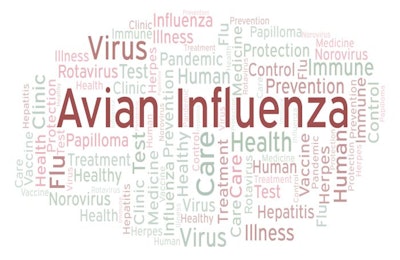
In South Korea, a wave of highly pathogenic avian influenza (HPAI) outbreaks that started in November continues to affect poultry flocks.
Latest update from the country’s agriculture ministry puts the number of farms affected by the H5N1 virus serotype at 43. Testing positive for the virus have been 20 duck flocks, 14 of laying hens, two each of native chickens and quails and one of poultry breeders. Outbreaks have occurred widely across the southeastern part of the country in four provinces and the Sejong city region.
Most recently affected was a farm with 96,000 broilers in the Jincheon county in North Chungcheong. It was confirmed on February 14. Located around 90 kilometers south of Seoul, previous cases have been detected in this county.
Following an earlier 48-hour suspension of poultry movements across the country, a period of widespread disinfection has been extended by one week, reported Yonhap.
Over the past three weeks, South Korea’s veterinary authority has officially registered 23 HPAI outbreaks in poultry. These were confirmed between January 14 and February 12.
Directly impacted as a result of mortality or culling have been more than 2.99 million poultry, according to notifications to the World Organisation for Animal Health (OIE).
These bring to more than 4.8 million the total number of poultry affected by HPAI in South Korea since November. All these outbreaks have been reported on farms.
In addition to the disinfection programs, the ministry has announced intensified testing of birds on farms. From now on, all poultry will have to be tested for HPAI before they are transported to a slaughterhouse. During rearing, ducks will be subjected to 3-4 tests, and other poultry once every two weeks. Frequency of sampling on farms within 3 kilometers of a confirmed outbreak has been increased to once every five days.
Two new outbreaks in Japan
The number of HPAI outbreaks confirmed in Japan this winter has risen to 16. Of these, 14 have involved the H5N1 virus serotype. In addition, two poultry flocks tested positive for the H5N8 variant during November of 2021.
On January 25, ducks at a farm in Chiba prefecture tested positive for the H5N1 virus, according to the OIE report.
Following observation of dips in egg production and feed intake, just one of the 5,800 ducks died. The remaining birds at the premises were destroyed. At four epidemiologically linked farms, all poultry were also culled to reduce the risk of infection spreading.
This winter, previous outbreaks have occurred in Chiba, which is in the Kanto region of Honshu island, around Tokyo.
One week ago, 45,000 chickens were scheduled for culling after testing positive for HPAI. According to Japan Times, mortality increased at the farm in Kuji in Iwate prefecture.
This is the first HPAI outbreak in Iwate. Part of the Tohoku region, Iwate is in the north-east of Honshu.
HPAI returns to eastern Indian, Nepal
For the first time in more than two years, the H5N1 HPAI virus has been detected in Bihar in the east of India.
According to the recent OIE notification, almost 800 of the around 3,800 poultry died at the affected farm in mid-January. The premises was the Poultry Research and Training Centre in Patna. The source of the infection is unknown.
In Nepal, wild birds seen nearby are thought to have transmitted the H5N1 HPAI virus to a farm in January. Up to the end of that month, the infection had been confirmed at five farms in the country.
Affecting a total of more than 11,000 poultry, all infected premises were in the Morang district of Province 1 (East) of Nepal. While the initial outbreak was in laying hens, subsequent cases have occurred in broilers, native chickens, and one mixed backyard flock.
Morang borders the Indian state of Bihar.
Further outbreaks in Taiwan, Vietnam
Between January 28 and February 7, the H5N1 HPAI virus was detected in four Vietnamese village poultry flocks.
According to the latest OIE notification, these directly affected a total of 13,600 poultry in flocks, each with 2,000-5,500 birds. Two of the outbreaks were in Quang Nam in the South Central Coast region, while others were in Ha Noi (Red River Delta) and Quang Binh (North Central Coast).
Since the first cases in the current outbreak wave outbreak were confirmed in mid-October last year, the number of village flocks affected has risen to nine. These have involved around 31,700 poultry in four regions of Vietnam.
In contrast to other Asian nations, infections with the H5N2 HPAI virus serotype have been affecting Taiwan’s poultry sector.
Since November of 2021, the number of confirmed outbreaks has reached 21. Affecting around 322,500 poultry in total, all cases so far have been on commercial farms.
Over recent weeks, the authorities in Taiwan have registered eight new outbreaks with the OIE. Starting between January 4 and February 2, the virus was detected at four farms in each of the counties of Changhua and Yunlin. Three of the outbreaks were in laying hens, and two in broiler breeders. Also affected were breeding geese, meat geese, and native chickens.
New cases registered in Asian wild birds
A further 13 wild birds in South Korea have tested positive for the H5N1 HPAI virus, and one for the H5N8 virus serotype. This is according to the latest reports to the OIE.
Israel’s veterinary authority has registered with the same agency the detection of the H5N1 variant in one more wild bird.
China records two new human infections with flu of avian origin
To the World Health Organization (WHO), Chinese authorities have registered the first cases of avian influenza A(H5N6) virus in humans of 2022.
Testing positive for this virus serotype were a 68-year-old man from Sichuan province, and a 55-year-old woman from Zhejiang province. Admitted to hospital in the first days of January, both had previous exposure to poultry. At the time of reporting, the patients were in a critical conditions. No family members were infected.
According to the WHO, a total of 66 lab-confirmed cases of human infection with this flu virus serotype have been reported in the Western Pacific Region since 2014. Of these, 29 patients died.
View our continuing coverage of the global avian influenza situation.

















